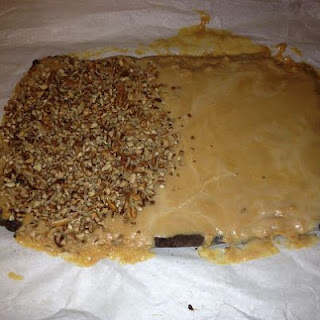The Salmon recipe and the Pomegranate-Balsamic Glaze recipe are from Cook's Illustrated.
For the Pomegranate-Balsamic Glaze
Ingredients:
3 tablespoons light brown sugar
3 tablespoons pomegranate juice
2 tablespoons balsamic vinegar
1 tablespoon whole grain mustard
1 teaspoon cornstarch
pinch cayenne pepper.
1 teaspoon cornstarch
pinch cayenne pepper.
Instructions:
1. Whisk all ingredients together in small saucepan
2. Bring to boil over medium-high heat
3. Simmer until thickened - about 1 minute
4. Remove from heat and cover to keep warm
5. Set aside until needed for the salmon
Mark's Notes -
I substituted white sugar for the brown sugar.
Pomegranate juice is incredibly difficult to find. I used Ocean Spray's Cranberry-Pomegranate juice.
Cayenne pepper = Ground red pepper (I didn't know that).
Salmon:
Ingredients:
1 teaspoon light brown sugar
1/2 teaspoon salt
1/4 teaspoon cornstarch
4 center-cut skin-on salmon fillets (6-8 ounces each)
Ground black pepper
1 teaspoon vegetable oil
1 recipe glaze (see above)
Instructions:
1. Adjust oven rack to middle and heat to 300 degrees.
2. Combine brown sugar, salt, and cornstarch in a small bowl.
3. Pat salmon dry with a paper towel.
4. Season salmon with the black pepper.
5. Sprinkle brown sugar mixture over top of flesh side of salmon.
6. Rub in mixture to distribute.
7. Heat oil in 12 inch skillet over medium-high heat until just smoking.
8, Place salmon flesh side down in skillet.
9. Cook until well browned (about 1 minute)
10. Using tongs, carefully flip salmon fillets and cook on skin side for 1 minute.
11. Remove skillet from heat.
12. Spoon glaze evenly over flesh side of the salmon fillets.
13. Transfer salmon fillets to a rimmed baking sheet.
14. Bake in oven until thickest parts of fillets reach 125 degrees (about 7-10 minutes).
15. Enjoy!
Mark's Notes:
1. Again, I don't use brown sugar and used regular white sugar.
2. If using an oven-safe skillet, then after glazing the salmon, the skillet can go directly into the oven (skipping step 13).
3. If you notice "white stuff" that forms on salmon - this is a protein known as albumin. According to Cook's Illustrated -
"When the muscle fibers in the fish are heated, they contract, pushing the moisture-filled albumin to the surface of the flesh. Once this protein reaches temperatures between 140 and 150 degrees, its moisture is squeezed out, and it congeals and turns white. Not only does the white albumin detract from the salmon's appearance, but its formation indicates a loss of moisture in the fish. Cooking salmon at a low temperature can mitigate albumin coagulation. Gentle cooking results in less intense muscle contractions, so that less of the albumin moves to the surface of the fish and more of it stays trapped in the flesh. The fish not only stays more moist, but it looks better too."
Mark's Amusing Story:
Trish was complaining about all the baking that I do. She said I should try baking something healthy that she can eat. She eats lots of fish. So, I searched through Cook's Illustrated recipes for fish and found one that I liked. I called Trish and told her I was making dinner tonight and that it was a surprise. I got the fresh salmon from Mitchell's Fish Market too. It was really really good.

